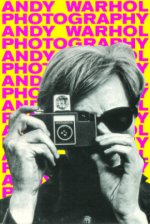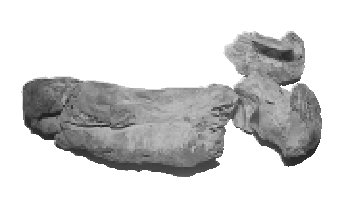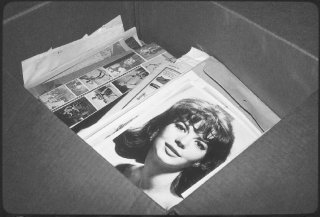 The Anthropologist
and the Time Capsules The Anthropologist
and the Time Capsules
By Jordan Weeks
"You should try to keep track of it, but if you can’t
and you lose it, that’s fine, because it’s one less thing to think about,
another load off your mind."
-Andy Warhol
You can see the toes here. It’s probably Egyptian.
It’s been bobbed, too; it’s been wrapped, that’s why it’s not very large.
This part comes up to the bottom of the ankle, where it’s attached to the
ankle. It’d be interesting to X-ray it—you could tell a lot more about
it."
What has Jim Richardson, curator of anthropology at Carnegie Museum
of Natural History, so rapt with attention? Well, among the 600-odd boxes
of Warhol’s personally stored belongings at The Andy Warhol Museum, a mummified
foot was found. Yes, Warhol did have a foot fetish, but…isn’t this extreme?
 "Not really," says head Warhol archivist John Smith. "Andy went to a lot
of yard sales and flea markets in New York; we believe it was something
he just picked up there."
"Not really," says head Warhol archivist John Smith. "Andy went to a lot
of yard sales and flea markets in New York; we believe it was something
he just picked up there."
Ah…New York…a flea market. It all begins to come together.
You see, whenever Warhol cleared off his desk, or felt like organizing
a bit, he pretty much put everything into an open box he kept by his desk.
On a regular basis, he would tape the box up, label it with dates for reference,
file it away, and put a new, empty box in its place, ready for the next
month’s sundry accumulations. So far about 100 of the boxes have been opened
and examined. As the archivists at The Warhol have discovered, nearly everything
was fair game for inclusion in these boxes, which Andy dubbed "Time Capsules"…even
the odd, mummified foot.

Richardson and Smith recently examined one of Warhol’s Time Capsules
(or, "TCs" as Warhol called them), and exchanged ideas on the anthropological,
archaeological, and art historical significance of these all-inclusive
boxes.
"We never know what we’re going to find," attests Smith, who oversees
and maintains the entire archival collection at The Warhol, and, when time
permits, joins assistant archivist Matt Wribican in going through the next
Time Capsule with a fine-toothed comb. "Warhol started putting this stuff
together in the 1940s," Smith continues, "and we have no idea where a lot
of it came from. He was saving everything from day one, but then in 1974,
when he was moving from one apartment to another, he and his associates
went out and bought these boxes to accomplish the move. So several hundred
boxes really are a mixture of things, representing different dates and
periods." Smith adds that after Warhol was audited by the Internal Revenue
Service, he became more methodical about keeping his correspondence and
records. At times he would ask an associate to use the boxes for research.
It was a loose filing system for everything in Warhol’s past.
Warhol’s TCs are unlike official "Time Capsules" says Richardson, which
usually conform to several basic rules. Official Time Capsules have pre-determined
"expiration" or "opening" dates, and the items placed in them are chosen
for special historical significance which the capsule assemblers consider
important. The contents of Warhol’s TCs were unplanned, and their future
use was uncertain. "It seemed as if he’d come in and empty his pockets
directly into a Time Capsule," assessed Richardson.
Warhol seemed to place the same significance (or insignificance) on
everything, from articles clipped from newspapers, to checks for $2,000
(a few checks were found uncashed in TCs). He boxed everything from daily
receipts, tickets and letters to the handwritten lyrics for Lou Reed’s
Velvet Underground tune "Heroin," and the used paintbrushes that Salvador
Dali gave him as a present in the late 1970s.
Anthropologists like Richardson focus on "material culture" – the found
artifacts and objects used to assess a society in the absence of a written
history that explains a culture’s politics, religion, or the daily uses
of objects. Richardson says there is no historic precedent for Warhol’s
Time Capsule habit, especially since after the early 1970s it was accompanied
by tape-recorded (and later transcribed and published) diaries, sometimes
explaining in great detail objects that were found later in the Capsules.
It was a tape that identified the paintbrushes as a gift from Dali.
The assemblage of Warhol’s Time Capsules, says Richardson, "is different
because it’s a wide variety of items which are somewhat systematic in their
inclusion, but they are drawn from everywhere, from every venue of Warhol’s
life. In contrast, royal tombs collections reveal that everything has been
prepared and the placed in the tombs." Warhol’s intentions (if indeed
he had any) concerning the preservation of these items is unclear. But
today they fascinate researchers interested in Warhol and the art and popular
culture of the 1940s through 1987—the year the artist died.
Warhol has been described as his own greatest creation. Anthropologist
Jim Richardson’s agrees: "Basically, he collected himself."
The Archives at The Andy Warhol Museum will be closed to researchers
through March 2000 in order to devote time to cataloguing additional archival
material
Fame After Photography
January 8 Lecture: Museum Theater, 7pm
In a special program at The Warhol, guest lecturers Marvin Heiferman and
Carole Kismaric, curators of the Museum of Modern Art’s recent Fame
After Photography exhibit, will discuss fame, photography, and the
inevitable intermingling of the two in our culture.
The Warhol’s two current photography shows, Nadar/Warhol: Paris/New
York, and Andy Warhol: Photography, are full of the crosscurrents
of these subjects.
Heiferman says, "Our understanding of fame has been changed since the
invention of photography." He argues that more widespread use of photography
has changed the public perceptions about people and their accomplishments.
"What looks good in pictures begins to define what is good in culture and
society at large."
Warhol and Nadar each emerged from the Bohemia of his day, and both
used photography to create and consecrate a circle of famous people. In
the 1960s-1980s, Warhol, like the famous showman P. T. Barnum, "understood
fame and photography in a broad context, and how the two work together
in a world larger than just the world of images or the world of art." In
addition to portraying people in graphic design, painting and filmmaking,
Warhol used photography to popularize the modern celebrity culture. Nadar,
active in Paris in the 1850s-1860s, added photography to earlier pursuits
as a journalist and caricaturist. He captured in unforgettable portraits
the famous people of his day, such as actress Sarah Berhardt, artists Gustave
Doré and Jean Francois Millet, and writers like Alexandre Dumas
and George Sand.
DIY-burg
Symposium Yields "Do-It-Yourself" Urban Ideas
Last September’s "When You Wish Upon a Star: Themed Worlds" symposium
at The Warhol challenged those who criticize artificially imposed urban
themes and "generic cities" to produce their own creative, feasible, and
fantasy alternatives to the homogenization, and the future "theming" of
Pittsburgh. A basic concern was that the city would try to revitalize itself
by destroying historically significant landmarks that individualize the
city, and replace them with cookie-cutter department and chain stores and
theme restaurants--cheap labor-driven cultural vacuums--that could destroy
the uniqueness of Pittsburgh.
The Edge Architects, and Barry Hannegan, Pittsburgh History and Landmarks
Foundation’s Director for Historic Landscape Preservation, looked at the
city’s past dependence on the rivers, and the current river uses for commerce
and transportation, and conceived of a Venice-like downtown with water
replacing streets in designated areas. Pittsburgh would have water taxis
and buses, floating garages, and floating gardens.
Installation artist Bob Bingham and Quantum Theater founder and producing
director Karla Boos’s proposal focused on the city’s capacity for flora
and fauna, and a desire to "restore the ecosystem with creative reuse of
all buildings and resources." Chatham College electronic art professor
Steffi Domike and video artist Curtis Reaves proposed changing the city’s
infrastructure by adding new inclines, steps, and stairways, repairing
the old ones, and organizing walking and bicycle tours, and photo surveys.
"A place where smokestacks become
poems
and poetry is a game."
Laurie Graham, author of Singing the City, and Christina Springer, director
of Sun Crumbs artists’ organization, proposed a "writing on steel bones"
by means of "The Great Pittsburgh Poem Chase." Lines from a poem about
Pittsburgh, or that incorporate a Pittsburgh theme, would be scattered
about the city at different locations such as the Bayer Clock, billboards,
theater marquees, the trusses of bridges, or the sides of buses.
Poems would be solicited from Pittsburgh poets, and artwork from Pittsburgh
artists.
Each line of the poem would be numbered and participants would assemble
them in an order to "solve" the problem. A reconstructed poem would be
logged onto a website, and if the input provided the right answer, the
person would be eligible for a prize. The Greater Pittsburgh Poem Chase
would celebrate Pittsburgh’s working artists, and would unify life and
art in the city. There would be a new contest each month, and eventually
an anthology would be published. Both Graham and Springer are now hard
at work to realize this project.
The Warhol Community Project, a collaboration between teenagers, architects,
and neighborhood residents, worked with a playful Disney theme and redesigned
the Golden Triangle as a giant theme ride with an Egg Public Transport
system, an egg-shaped, multi-terrain elevator/boat/gondola/submarine. Included
were a Demolition Park where everyone could blow stuff up, and a community
"food court," featuring different ethnic cuisine from the area’s churches
and places of worship.

Andy Does the Olympics
Celebrate the Olympics with a rare poster designed by Andy Warhol
for the 1984 Sarajevo Winter Olympics. The International Olympic Committee
commissioned the poster, which captures the energy of a speed skater in
Warhol’s inimitable style. The poster plates were destroyed after a limited
edition printing; only 44 posters remain. Purchase yours for $60 in The
Andy Warhol Museum Store or online at www.warhol.org.
|

